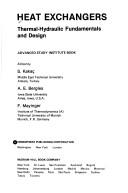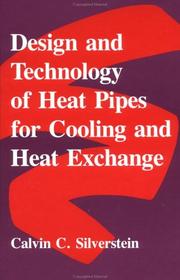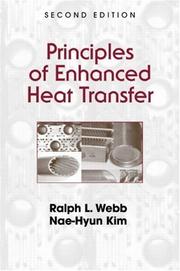| Listing 1 - 10 of 26 | << page >> |
Sort by
|

ISBN: 0891162305 Year: 1990 Publisher: New York, NY : Hemisphere Publishing Corporation,
Abstract | Keywords | Export | Availability | Bookmark
 Loading...
Loading...Choose an application
- Reference Manager
- EndNote
- RefWorks (Direct export to RefWorks)
Book
ISBN: 9781439849903 Year: 2012 Publisher: Boca Raton : CRC Press, Taylor & Francis,
Abstract | Keywords | Export | Availability | Bookmark
 Loading...
Loading...Choose an application
- Reference Manager
- EndNote
- RefWorks (Direct export to RefWorks)
Heat exchangers are essential in a wide range of engineering applications, including power plants, automobiles, airplanes, process and chemical industries, and heating, air conditioning and refrigeration systems. Revised and updated with new problem sets and examples, Heat Exchangers: Selection, Rating, and Thermal Design, Third Edition presents a systematic treatment of the various types of heat exchangers, focusing on selection, thermal-hydraulic design, and rating. Topics discussed include: Classification of heat exchangers according to different criteria ; Basic design methods for sizing and rating of heat exchangers ; Single-phase forced convection correlations in channels ; Pressure drop and pumping power for heat exchangers and their piping circuit ; Design solutions for heat exchangers subject to fouling ; Double-pipe heat exchanger design methods ; Correlations for the design of two-phase flow heat exchangers ; Thermal design methods and processes for shell-and-tube, compact, and gasketed-plate heat exchangers ; Thermal design of condensers and evaporators. This third edition contains two new chapters. Micro/Nano Heat Transfer explores the thermal design fundamentals for microscale heat exchangers and the enhancement heat transfer for applications to heat exchanger design with nanofluids. It also examines single-phase forced convection correlations as well as flow friction factors for microchannel flows for heat transfer and pumping power calculations. Polymer Heat Exchangers introduces an alternative design option for applications hindered by the operating limitations of metallic heat exchangers. The appendices provide the thermophysical properties of various fluids. Each chapter contains examples illustrating thermal design methods and procedures and relevant nomenclature. End-of-chapter problems enable students to test their assimilation of the material. [Publisher]
Book
ISBN: 9283503783 Year: 1985 Volume: vol 390 Publisher: London : A.G.A.R.D. (Advisory Group for Aerospace Research and Development),
Abstract | Keywords | Export | Availability | Bookmark
 Loading...
Loading...Choose an application
- Reference Manager
- EndNote
- RefWorks (Direct export to RefWorks)
Combustion --- Échangeurs de chaleur --- Échangeurs de chaleur --- Refrigeration and refrigerating machinery.

ISBN: 0070332843 0891162259 3540152431 Year: 1981 Publisher: Washington, DC : Berlin : Hemisphere Publishing Corporation, Distrubution outside North America Springer ,
Abstract | Keywords | Export | Availability | Bookmark
 Loading...
Loading...Choose an application
- Reference Manager
- EndNote
- RefWorks (Direct export to RefWorks)
Heat exchangers --- Thermal hydraulics --- Échangeurs de chaleur --- Thermodynamique --- Hydraulique --- Échangeurs de chaleur. --- Échangeurs de chaleur

ISBN: 0891168591 Year: 1995 Publisher: New York, NY : Hemisphere Publishing Corporation,
Abstract | Keywords | Export | Availability | Bookmark
 Loading...
Loading...Choose an application
- Reference Manager
- EndNote
- RefWorks (Direct export to RefWorks)
Heat pipes. --- Technologie --- Technology --- Échangeurs de chaleur --- Technology. --- Échangeurs de chaleur --- Refrigeration and refrigerating machinery.

ISBN: 9780471321712 Year: 2003 Publisher: Hoboken, NJ : John Wiley,
Abstract | Keywords | Export | Availability | Bookmark
 Loading...
Loading...Choose an application
- Reference Manager
- EndNote
- RefWorks (Direct export to RefWorks)
Échangeurs de chaleur --- Heat exchangers --- Conception et construction. --- Design and construction. --- Échangeurs de chaleur
Book
ISBN: 295025554X Year: 1989 Publisher: Paris : Technique & Documentation - Lavoisier,
Abstract | Keywords | Export | Availability | Bookmark
 Loading...
Loading...Choose an application
- Reference Manager
- EndNote
- RefWorks (Direct export to RefWorks)
Thermodynamics. --- Échangeurs de chaleur --- Systèmes d'aide-mémoire --- Thermodynamique --- Transfert de chaleur

ISBN: 1591690145 Year: 2005 Publisher: Boca Raton : Taylor & Francis,
Abstract | Keywords | Export | Availability | Bookmark
 Loading...
Loading...Choose an application
- Reference Manager
- EndNote
- RefWorks (Direct export to RefWorks)
This book is essential for anyone involved in the design of high-performance heat exchangers or heat devices, also known as "second generation heat transfer technology." Enhanced surfaces are geometrics with special shapes that promote much higher rates of heat transfer than smooth or plain surfaces. This revision presents the subject matter just beyond the introductory level and traces the advancement of heat transfer research in areas such as integral-fin and micro-fin tubes, complex plate-fin geometries, and micro-channels for single-phase and two-phase applications. [Publisher]
Heat --- Heat exchangers --- Transfert de chaleur --- Échangeurs de chaleur --- Transmission --- Échangeurs de chaleur
Book
ISBN: 9781119467403 Year: 2022 Publisher: Hoboken, NJ : Wiley,
Abstract | Keywords | Export | Availability | Bookmark
 Loading...
Loading...Choose an application
- Reference Manager
- EndNote
- RefWorks (Direct export to RefWorks)
Heat transfer is a discipline of thermal engineering that concerns the generation, use, conversion, and exchange of thermal energy and heat between physical systems. Heat transfer is classified into various mechanisms, such as thermal conduction, thermal convection, thermal radiation, and transfer of energy by phase changes. Engineers also consider the transfer of mass of differing chemical species, either cold or hot, to achieve heat transfer. While these mechanisms have distinct characteristics, they often occur simultaneously in the same system. Heat transfer has broad application to the functioning of numerous devices and systems. Heat-transfer principles may be used to preserve, increase, or decrease temperature in a wide variety of circumstances. Heat transfer methods are used in numerous disciplines, such as automotive engineering, thermal management of electronic devices and systems, climate control, insulation, materials processing, and power station engineering.
Heat --- Heat --- Heat exchangers. --- Transfert de chaleur. --- Chaleur --- Échangeurs de chaleur. --- Transmission. --- Convection. --- Convection.
Book
ISBN: 2877772403 Year: 1990 Publisher: Paris : Technique & Documentation - Lavoisier,
Abstract | Keywords | Export | Availability | Bookmark
 Loading...
Loading...Choose an application
- Reference Manager
- EndNote
- RefWorks (Direct export to RefWorks)
Thermodynamics. --- Échangeurs de chaleur --- Systèmes d'aide-mémoire --- Thermodynamique --- Transfert de chaleur
| Listing 1 - 10 of 26 | << page >> |
Sort by
|

 Search
Search Feedback
Feedback About UniCat
About UniCat  Help
Help News
News